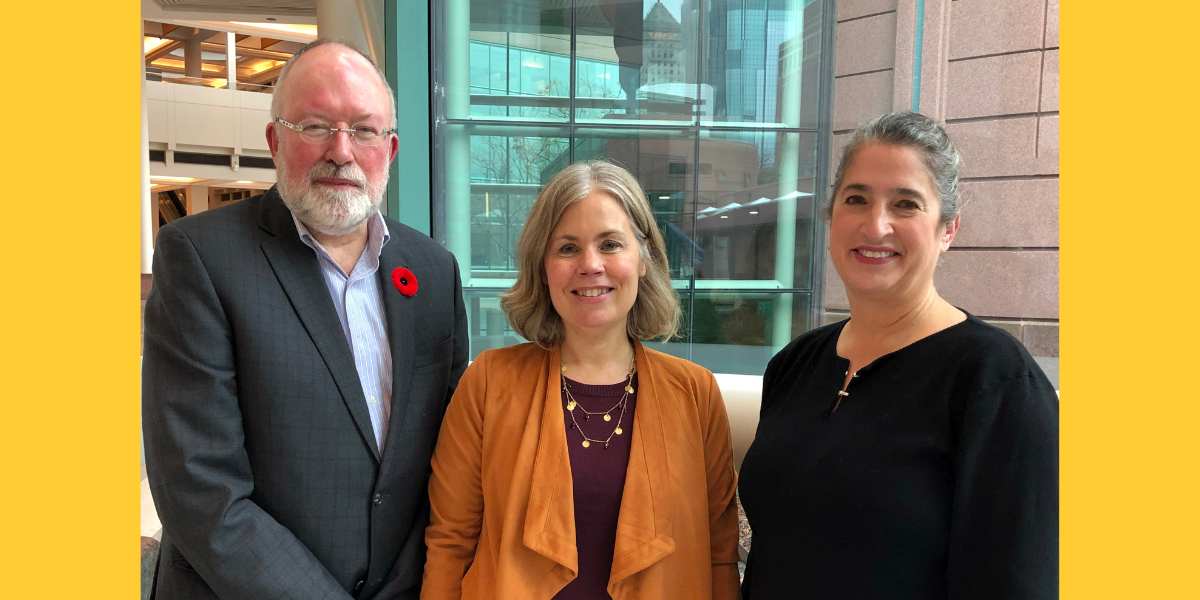On alert
CVM faculty explain looming threats to MN agriculture

CVM faculty explain looming threats to MN agriculture
(Left to right) Drs. John Deen, Laura Molgaard, and Carol Cardona attend Minnesota AgriGrowth’s annual meeting. Photo by Martin Moen.
Animal diseases are causing both chronic and acute problems for Minnesota’s agricultural producers and industry. From porcine reproductive and respiratory syndrome (PRRS) in pigs to highly pathogenic avian influenza (HPAI) in poultry and numerous other diseases, the economic impacts are increasing. The zoonotic potential of some diseases to affect other species—including wildlife and humans—increases the impact of animal disease.
Understanding the current and future for animal diseases and agriculture was the focus of a presentation by Dr. John Deen and Dr. Carol Cardona. They spoke to hundreds of the region’s agribusiness leaders at Minnesota AgriGrowth’s annual meeting. Their opportunity was arranged by College of Veterinary Medicine Dean Dr. Laura Molgaard.
Molgaard introduced the presentation by recognizing that animal disease threats need to be framed as a widespread program.
“Emerging diseases are a major threat and constraint, not only on livestock production in Minnesota and the Upper Midwest but also to the whole food supply system, from the crops that are raised to feed livestock to the grocery stores that sell the product,” she says.
Recent disease threats are becoming more global in their impact, Cardona noted.
“Previously, there were Eurasian strains of HPAI that did not interact with strains in the Americas," she says. "Today, these microbial pathogens share genetic information, making them more formidable to control. For instance, the HPAI strain that caused much of the 2022 outbreak had its genetic origins in Eurasia.”
The global reach of the strains makes eradication a more distant achievement because of the difficulties of coordinating actions across dozens of countries.
This globalization of animal disease may be less apparent in Minnesota. “We need to acknowledge our privileged position,” Deen says. “We have strong biosecurity and disease surveillance networks, but the rest of the world hasn’t been as fortunate.”
The economic impacts of animal disease often go unnoticed. For example, PRRS is estimated to cost the United States pork industry more than $660 million annually. Estimates of the impact of African swine fever on the U.S. pork industry range from $15 to $50 billion, depending on how quickly the deadly disease is brought under control. Meanwhile, this year’s HPAI outbreak in the U.S. has caused widespread shortages of poultry food products and sharply higher prices at the grocery store.
Prevention, preparation, and response have been the key ingredients in past efforts to address emerging animal disease threats. While those are still useful strategies, Deen pointed out that plans can give a false sense of security.
“The boxer, Mike Tyson, is credited with saying that everyone has a plan until they are punched in the mouth. We need to be ready to counter-punch the unpredictable qualities of today’s animal diseases,” he concludes.
Past disease outbreaks were also characterized by gaps in time that allowed people to reflect and learn. Today, outbreaks are coming more frequently.
“We’re getting better at our early response to outbreaks,” Cardona says. “With HPAI, many of the people who were present for the 2015 outbreak are still here, and they remembered how to react. That’s why we were able to limit the losses in commercial flocks compared to 2015.”
Cardona says the 2022 outbreak threw some new curves. For example, the 2022 HPAI strain produced larger amounts of virus, which made it far more deadly for wildlife, including raptors.
“We need to adapt our poultry farming systems to the reality that wild birds will always be present—that HPAI will always be a risk,” she says.
Cardona and Deen are united in describing how biosecurity efforts are evolving as our understanding of animal diseases improves, and also that there is no “local” in when confronting animal diseases affecting agriculture. They outlined critical steps that should be taken to better address recurrent and emerging animal diseases.
The first is people-related. “We need a dedicated workforce that is constantly ready to respond to an outbreak,” Deen recommends. The growing complexity, the urgency for an appropriate initial response, and the increasingly compressed time between outbreaks make having an experienced team ready to go an important asset.
A second action is to develop alternative intervention strategies to increase the number of available tools. Creating alternatives in a systematic, thoughtful way would be more efficient than trial and error and luck.
A third necessary step is the development of more flexible and innovative training programs to help the various agricultural sectors stay ready. Cardona says agriculture needs to evolve as quickly as the disease threats. Widely available programs that teach critical thinking skills as much as specific actions will be important.
A fourth action is the development of mass vaccination strategies. While vaccines are either unavailable or only capable of limiting the severity of the disease, Cardona recommends preparing now for the day when better vaccines are available.
“Perhaps the best we can promise (with these steps), is to make things better for the agricultural industry,” Cardona says. “I think any form of progress will be welcome.”